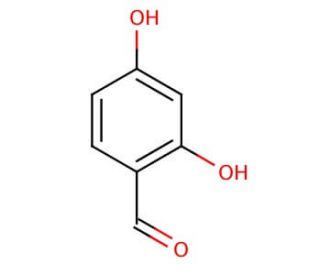

2,4-Dihydroxybenzaldehyde 的分子结构, CAS编号: 95-01-2
2,4-Dihydroxybenzaldehyde (CAS 95-01-2)
备用名:
β-Resorcylaldehyde
应用:
2,4-Dihydroxybenzaldehyde 是一种间苯二酚 (sc-203371) 衍生物,具有强大的抗氧化和抗菌活性
CAS号码:
95-01-2
分子量:
138.12
分子式:
C7H6O3
仅供科研使用。不可用于诊断或治疗。
* 参考分析证明 大量特定数据 (包括水 含量).
快捷链接
订购信息
描述
技术信息
安全信息
安全技术说明书和分析证明书
2,4-二羟基苯甲醛是一种芳香醛,其特点是两个羟基分别位于苯环的第 2 位和第 4 位,与一个醛基相邻。这种结构排列有助于其化学反应活性和参与各种有机合成反应的能力。羟基的存在提高了它在极性溶剂中的溶解度,并因其提供氢原子和稳定自由基的能力而具有抗氧化特性。在研究方面,2,4-二羟基苯甲醛已被广泛用作合成化学的基本成分,用于生产更复杂的有机化合物。2,4- 二羟基苯甲醛的醛基使其能够与含有胺基团的化合物发生缩合反应,从而合成希夫碱,希夫碱的应用范围很广,包括开发新材料、催化剂和配位化学中的配体。此外,这种化合物还被用于研究从植物中提取的天然酚类化合物,作为一种模型化合物来了解具有类似结构的天然物质的行为。研究人员还研究了它在聚合物化学中的潜在作用,利用它在聚合物链中形成稳定芳香环的能力,制造出具有抗紫外线和增强耐久性等特定性能的聚合物。
2,4-Dihydroxybenzaldehyde (CAS 95-01-2) 参考文献
- 从决明中提取的一种新的 C6-C3 化合物。 | González, AG., et al. 1996. Planta Med. 62: 176-7. PMID: 17252432
- 用于伯胺基质辅助激光解吸电离质谱分析的反应基质。 | Zaikin, VG., et al. 2015. Eur J Mass Spectrom (Chichester). 21: 403-11. PMID: 26307721
- 二甲双胍席夫碱的 Pr3+ 复合物的模板合成, 光谱, 热敏和葡萄糖传感。 | Mahmoud, M., et al. 2019. J Fluoresc. 29: 319-333. PMID: 30652231
- 制备用于从水溶液中去除放射性 U(VI) 和 Eu(III) 离子的高多孔聚合物纳米复合材料。 | Ahamad, T., et al. 2020. Polymers (Basel). 12: PMID: 33316959
- 新型苯并咪唑席夫碱与合成及模拟细菌和哺乳动物膜模型的相互作用研究。 | Aragón-Muriel, A., et al. 2021. Membranes (Basel). 11: PMID: 34208443
- 具有大斯托克斯偏移的新型水溶性裸眼探针,用于选择性光学感测 Hg2+,及其在水样和活细胞中的应用。 | Zhang, Y., et al. 2019. RSC Adv. 9: 23382-23389. PMID: 35514512
- 用 2,4-二羟基苯甲醛和 5-溴水杨醛修饰二氧化硅纳米颗粒,使其成为新型纳米复合材料,用于高效去除和预浓缩水, 血液和鱼类肌肉中的铜(ii)和镉(ii)离子。 | Gad, HM., et al. 2022. RSC Adv. 12: 19209-19224. PMID: 35865597
- 在低温基质中通过紫外线诱导的构象变化破坏和形成二羟基苯甲醛的分子内氢键 | Doddipatla, S., et al. 2022. J Phys Chem A. 126: 8645-8657. PMID: 36373975
- 基于席夫碱受体喹啉衍生物的 Zn2+ 检测机制的理论研究。 | Wen, J., et al. 2023. Spectrochim Acta A Mol Biomol Spectrosc. 287: 122123. PMID: 36423505
- 构建含双层 Silsesquioxane 的荧光共轭聚三唑:点击聚合与热稳定性。 | Chiang, CH., et al. 2023. Polymers (Basel). 15: PMID: 36679213
- 用于动态 Pd2+ 跟踪的 PET 荧光探针在纳米纤维和活细胞中的成像应用。 | Cheng, Z., et al. 2023. Molecules. 28: PMID: 37049828
激活剂:
Olfr642.订购信息
| 产品名称 | 产品编号 | 规格 | 价格 | 数量 | 收藏夹 | |
2,4-Dihydroxybenzaldehyde, 25 g | sc-238334 | 25 g | $57.00 |
